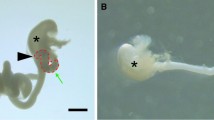Abstract
Histogenesis of the duodenum, especially changes in the epithelium in relation to temporal occlusion and re-canalization of the lumen, was investigated by light microscopy together with morphometric analysis, as well as by scanning and transmission electron microscopy of 133 externally normal human embryos ranging from Carnegie stage 12 to 23. A series of morphogenetic events passed the duodenum in a cranio-caudal (proximo-distal) wave like fashion during the period examined. They included: (1) a decrease in the caliber and area of the lumen, (2) ’occlusion’ of the lumen, (3) vacuole formation, (4) ’re-canalization’ and villi formation. The only exemption to this rule was that, in the upper part of the duodenum, the lumen was not obliterated in the embryos examined. Morphometric analyses revealed that both the area of the epithelium and the number of epithelial cells decreased during the ’occlusion’ phase. This result suggests that, unlike the classical view, epithelial cell proliferation does not play an important role in occluding the lumen, but the predominant morphogenetic event during this phase is convergence of the epithelial cells to elongate the duodenum. Apoptosis, contrary to some classical views, decreased during the ’re-canalization’ phase, and it appeared to be involved in the formation of the small lumens in the epithelial ’plug’ and in villi formation, but not in enlarging the secondary lumens. The secondary small lumens in the occluded lumen were frequently formed near the border between the central ’plug’ and peripheral basal cells on the basement membrane. This and other findings of concentric differentiation in both the epithelial and mesenchymal layers suggested a possible control mechanism by the epithelium-mesenchymal interaction on human duodenal morphogenesis and histogenesis. The present electron microscopic observations also provided details on the mechanisms involved in the enlargement of the secondary lumen and differentiation of villi. The implications of these findings to duodenal anomalies are also discussed.
Similar content being viewed by others
Author information
Authors and Affiliations
Additional information
Accepted: 12 November 2001
Rights and permissions
About this article
Cite this article
Matsumoto, A., Hashimoto, K., Yoshioka, T. et al. Occlusion and subsequent re-canalization in early duodenal development of human embryos: integrated organogenesis and histogenesis through a possible epithelial-mesenchymal interaction. Anat Embryol 205, 53–65 (2002). https://doi.org/10.1007/s00429-001-0226-5
Issue Date:
DOI: https://doi.org/10.1007/s00429-001-0226-5




